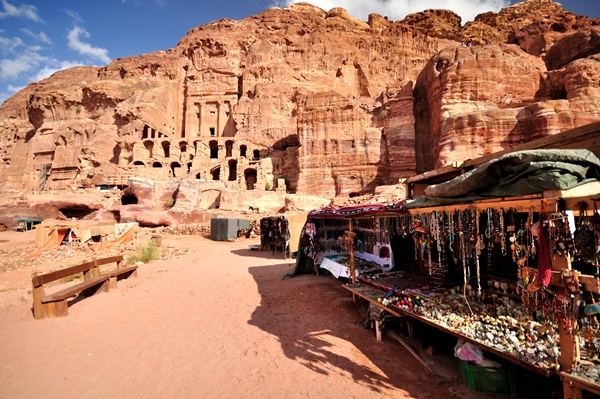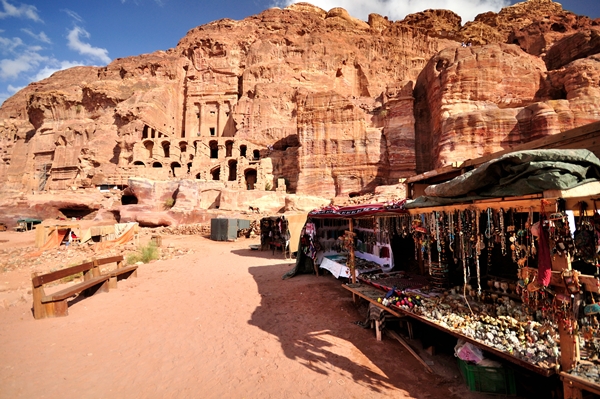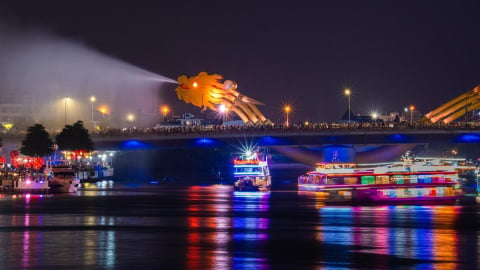
Step rAs we left Queen Alia International Airport, the capital city of Amman welcomed us with a hot, dry atmosphere and a faint scent of jasmine. The city stretches over seven hills with many modern buildings interspersed with ancient architecture. Thousands of years old and influenced by many great civilizations such as Greece and Rome, Amman has many monuments to visit. However, due to limited time, on this trip we only focused on exploring Petra.
After more than three hours by car from the capital, the group arrived at Petra, an ancient city located in a canyon completely isolated from the outside world on a rocky mountain range up to 1,000m above sea level. Petra is carved deep into the cliffs, surrounded by steep cliffs. To enter the ancient city, one must pass through the Siq, a narrow canyon more than 1km long with majestic, winding cliffs about 80m high on both sides.
The crimson color and the shape of the cliffs create a very eye-catching scene. World-famous for the color of the rock, Petra is also known as the “Rose Red City”. In fact, the color of the rock here is not only red but also different colors such as orange, yellow, purple, green, blue... The most beautiful moment of the day is in the middle of the morning or late afternoon, when the sunlight shines obliquely, highlighting the glorious color of the rock.

Once very famous in ancient times, Petra with 20 thousand people suddenly disappeared mysteriously for more than 1,400 years and was only rediscovered in 1802 thanks to the efforts of some Swiss experts. Located deep in a rocky valley, this city has a very dangerous and secret geographical location. The Roman Empire also attacked Petra once but was defeated and the generals swore never to return there again. According to researchers, Petra fell into ruin because it was abandoned, not invaded. But the reason for the abandonment has not been found yet.
Built in the 3rd century BC, Petra was the home of an Arab people called Nabatean. Located right at the crossroads of trade connecting China, India with Egypt and Rome, Petra was the transit point for the most luxurious goods of the time: silk, spices, precious stones, camels, olive oil and wine... Thanks to the very high taxes on these goods, this place became extremely rich and built massive, magnificent architectural works right in Petra.
Unlike all other cities of the time, the Nabateans did not use any outside building materials, they only used carving skills, carving deep into the surface of giant rocks to create columns, caves and giant roofs. This is also an amazing thing because the ancient Arab peoples were all nomadic and never left any trace showing the impressive level of construction architecture.
Petra used to include temples, royal residences and private homes. However, only the temples remain intact today. It would take four or five days for a tourist to visit them all. The architecture of Petra shows the close relationship between the city and neighboring civilizations. For example, the temple facades are built in the Greek and Roman style with huge columns and triangular eaves.

Our first stop was the Great Temple, which could seat 600 people. Its main motif was an elaborate elephant head carved in limestone. Nearby was a temple, part of which was set on a hill, dedicated to a winged lion, and inside was a Roman-style amphitheatre that could seat over 2,000 people. The stage and seats were also carved out of the rock.
In addition, Petra also has Roman-style churches that can accommodate up to three thousand people. There are towers, temples, places of worship and streets decorated with many rows of columns. Another place that cannot be missed is the Ad-Deir monastery located on a mountain. To get here, visitors have to climb 800 steps carved from stone in the scorching heat. But once up there, looking out at the whole city, everyone is overwhelmed by the magnificence of the scene and forgets all fatigue.
Petra also has countless tombs, most of which are located on the edge of the city. Many of them are extremely elaborately designed. The most famous tomb in Petra is Khazneh, which is 43m high and 30m wide with massive columns. The sculptures here are also extremely impressive with images of griffins, eagles, and vivid images of poppies, grapes, pomegranates, etc.
The rosette, the symbol of royalty, was also found. In addition to the level of stone carving, the Nabateans also impressed modern scientists with their water storage and distribution system, which was a series of stone cisterns and water pipes carved into the cliffs. Petra was surrounded by dry mountains, so the preservation of rainwater was a vital factor.


































